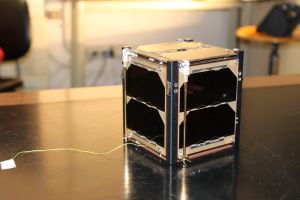What is... a Nano Satellite?
What is a Nano Satellite?
Nano satellites, also known as CubeSats or NanoSats, are small satellites that typically weigh less than 10 kilograms, measuring from 10 centimetres to 10 x 10 x 11.35 centimetres in size. They are an inexpensive way to send a satellite into orbit and have become increasingly popular in the aerospace industry. Nano satellites provide a range of applications including communications, Earth observation, remote sensing, and scientific research.
Nano satellites are transforming the space industry, providing new opportunities for exploration, data collection, and communication. With their low cost, small size, and incredible capabilities, nano satellites are opening up the final frontier to anyone with a dream.
The Benefits of Nano Satellites
Nano satellites have revolutionised space exploration by making it more accessible, affordable, and flexible. They offer a number of advantages that make them a powerful tool for scientific research and exploration.
 Nano satellites are far more affordable to launch into orbit compared to traditional satellites. They cost significantly less in both the development and launch stages and can be launched in large numbers at the same time. This makes them ideal for carrying out scientific research, communications, or observation missions in space.
Nano satellites are far more affordable to launch into orbit compared to traditional satellites. They cost significantly less in both the development and launch stages and can be launched in large numbers at the same time. This makes them ideal for carrying out scientific research, communications, or observation missions in space.
Due to their small size, nano satellites can stay in orbit for much longer than traditional satellites, making them an ideal choice for long-term observation and monitoring missions. As they are also easy to manoeuvre and reposition, they can be used to deploy payloads quickly in emergency situations.
Nano satellites also offer an unprecedented level of flexibility when it comes to mission design. With their compact design and low weight, they can be equipped with an array of sensors and instruments to collect data that was previously not possible. This provides the opportunity for new discoveries and insights about our universe.
Nano Satellites vs Regular Satellites
 Nanosatellites differ offer several advantages over traditional large satellites, also known as macro-satellites. One of the most notable differences is size. Microsatellites are significantly smaller and weigh less than traditional large satellites, which can weigh several tons. On top of making them easier and cheaper to launch, this smaller size also allows for faster development, with microsatellites able to be developed and launched in a fraction of the time it takes to develop traditional satellites.
Nanosatellites differ offer several advantages over traditional large satellites, also known as macro-satellites. One of the most notable differences is size. Microsatellites are significantly smaller and weigh less than traditional large satellites, which can weigh several tons. On top of making them easier and cheaper to launch, this smaller size also allows for faster development, with microsatellites able to be developed and launched in a fraction of the time it takes to develop traditional satellites.
Another key difference is cost. Traditional satellites are expensive to develop and launch, with costs often running into the hundreds of millions of dollars. Microsatellites, on the other hand, are significantly less expensive to develop and launch, making them more accessible to a wider range of organisations and businesses. This cost-effectiveness also allows for the deployment of multiple microsatellites in a constellation, providing a more robust and reliable service for the customers.
In terms of technology, microsatellites can also be equipped with the latest and most advanced technologies available, whereas traditional satellites may become obsolete by the time they are launched. Due to their smaller size, they can be more easily upgraded and modified to keep up with the latest advancements.
How Long Does it Take to Build a Nano Satellite?
The shorter development time of nano satellites is a defining feature that sets them apart from traditional large satellites. While traditional satellites can take years to design, build, and launch, nano satellites can be developed and deployed in a much shorter period. This has several implications for businesses and organisations looking to launch satellites.

With nano satellites, the reduced development window allows for the incorporation of cutting-edge technologies, giving organisations a competitive edge in their respective fields. Traditional satellites often become obsolete by the time they are launched, as technology can significantly advance during the design and build period.
Another advantage is the flexibility to adjust to changing market conditions. The traditional satellite development process is so lengthy that by the time it reaches orbit, the market it was intended to serve may have shifted. Nano satellites, on the other hand, can be developed and deployed in a matter of months, making them more responsive to new or emerging market needs.
A Career With Nano Satellites
The field of nanosatellites is interdisciplinary, and there are many career paths available for individuals with a range of backgrounds and skills. Whether you’re interested in engineering, operations, or business, there is a role for you in this exciting and growing field.
- Engineering: professionals in this field are involved in the design and creation of nanosatellites, utilizing expertise in aerospace, electrical, or mechanical engineering.
- Manufacturing: these experts play a crucial role in constructing and testing nanosatellites, ensuring they meet rigorous standards before launch.
- Operations: this area of the field involves controlling and monitoring nanosatellites once they are in orbit, and includes data analysis, system upkeep, and problem resolution.
- Program management: program managers oversee the development and launch of nanosatellites, making sure projects are completed on schedule, within budget, and to the required quality standards.
- Business development: business developers identify new markets and customers for nanosatellite technology, and establish relationships with key stakeholders.
- Research and development: this field involves advancing the current state of nanosatellite technology, discovering new applications and capabilities, and finding ways to make these systems more efficient and dependable.
- Sales and marketing: sales and marketing specialists promote nanosatellite technology to potential clients, provide technical support, and negotiate sales.
Nano Satellite Salary Guidelines
- Check out What is… A Satellite? for further satellite career guidelines.
Nano Satellite Geographic Hotspots
- New York
- London
- Los Angeles
- San Francisco Bay
- Washington DC-Baltimore
A career in the nanosat industry offers a chance to make an impact and drive the advancement of space technology. The industry is growing rapidly, with increased demand and investment, presenting a range of opportunities for those passionate about space and technology. From technical roles such as engineering, to business and management positions, entrepreneurship and innovation, the nanosat sector has a place for individuals with a variety of skills and interests. So, take the first step towards a fulfilling and exciting career in space by exploring the many job opportunities available in the nanosat industry.
If you like the sound of a career in Nanosats, there’s never been a better time to join this exciting sector. Check out our space jobs page to take the first step in your space career journey.
-
What Is… Synthetic Aperture Radar (SAR)?
Explore the capabilities and applications of Synthetic Aperture Radar in the space sector.Read More -
What Is… a Nano Satellite?
Explore the mini revolution of nano satellites and their impact on the space industry. Get insights on their size, functions, and potential future uses.Read More -
What Is… Space Debris?
Understand the issue of space debris and its impact on space missions. Get informed about the ongoing efforts to clean up space.Read More